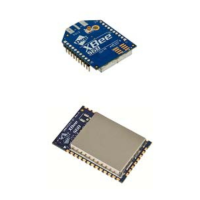Transmission, addressing, and routing Transmission timeouts
XBee/XBee-PRO® S2C ZigBee® RF Module
99
For example, suppose a router is configured with NH=30 (0x1E) and SP=0x3E8 (10,000 ms), and that it
is either trying to send data to one of its end device children, or to a remote end device. The total
extended timeout to the end device is approximately:
3 * ((50 * NH) + (1.2 * SP)) or one of the following:
n 3 * (1500 + 12000)
n 3 * (13500)
n 40500 ms
n 40.5 seconds
Transmission examples
Example 1: Send a unicast API data transmission to the coordinator using 64-bit address 0, with
payload “TxData”.
API frame
7E 0014 10 01 00000000 00000000 FFFE 00 00 54 78 44 61 74 61 AB
Field composition
0x0014 length
0x10 API ID (TX data)
0x01 Frame ID (set greater than 0 to enable the TX-status response)
0x00000000 00000000 64-bit address of coordinator (ZB definition)
0xFFFE Required 16-bit address if sending data to 64-bit address of 0
0x00 Broadcast radius (0 = max hops)
0x00 Tx options
0x54 78 44 61 74 61 ASCII representation of “TxData” string
0xAB Checksum (0xFF - SUM (all bytes after length))
Description
This transmission sends the string “TxData” to the coordinator, without knowing the 64-bit address of
the coordinator device. ZB firmware defines a 64-bit address of 0 as the coordinator. If the
coordinator's 64-bit address was known, the 64-bit address of 0 could be replaced with the
coordinator's 64-bit address, and the 16-bit address could be set to 0.
Example 2: Send a broadcast API data transmission that all devices can receive (including sleeping end
devices), with payload “TxData”
API frame
7E 0014 10 01 00000000 0000FFFF FFFE 00 00 54 78 44 61 74 61 AD

